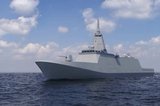First Saudi combat vessel build begins
Fincantieri Marinette Marine has commenced construction of the Royal Saudi Navy’s first Multi-Mission Surface Combatant (MMSC) ship.
Being delivered by Lockheed Martin as prime contractor, the four MMSCs were ordered in 2017 under a foreign military sales (FMS) agreement.
The FMS package request also included equipment to arm the vessels, including combat management systems with five TRS-4D radars. Also included were eight MK-41 Vertical Launch Systems and 532 tactical RIM-162 Evolved Sea Sparrow Missiles.
Saudi Arabia also requested five AN/SWG-l (V) Harpoon ship command launch control systems; eight Harpoon Shipboard Launchers; 48 RGM-84 Harpoon Block II Missiles; five MK-15 Mod 31 SeaRAM Close-In Weapon Systems; 188 RIM 116C Block II Rolling Airframe Missiles; five MK-75 76mm OTO Melara gun systems; and 48 50-calibre machine guns.
Related Equipment in Defence Insight
More from Naval Warfare
-
![Future Canadian Continental Defence Corvette will provide “Halifax-equivalent capabilities”]()
Future Canadian Continental Defence Corvette will provide “Halifax-equivalent capabilities”
Although the CDC project is still in its early stages, the Canadian Department of National Defence already has some requirements for the future platforms.
-
![US Navy to acquire micro-uncrewed underwater vehicles for ISR and coastal data collection]()
US Navy to acquire micro-uncrewed underwater vehicles for ISR and coastal data collection
The Naval Supply Systems Command is seeking authorised resellers of JaiaBot uncrewed underwater vehicles and multivehicle pods. The platforms will support undergraduate education at the US Naval Academy.
-
![NATO tests use of “undetectable, jam-proof” laser communication in maritime scenarios]()
NATO tests use of “undetectable, jam-proof” laser communication in maritime scenarios
As part of its effort to better prepare its capabilities for operations in contested and congested scenarios, NATO evaluated a Lithuanian ship-to-ship terminal designed to not be susceptible to enemy interference.
-
![Future of the Canadian Patrol Submarine Project is still unclear]()
Future of the Canadian Patrol Submarine Project is still unclear
The Canadian government remains tight-lipped on the timeline and funding required for the next steps of its Canadian Submarine Patrol Project, which should offer improved capabilities for the country’s navy.
-
![Mitsubishi eyes future with Australia’s Mogami selection]()
Mitsubishi eyes future with Australia’s Mogami selection
With Australia’s selection of the Mogami-class for Project Sea 3000, Mitsubishi is investigating local production in the next decade as potential export opportunities emerge.
























